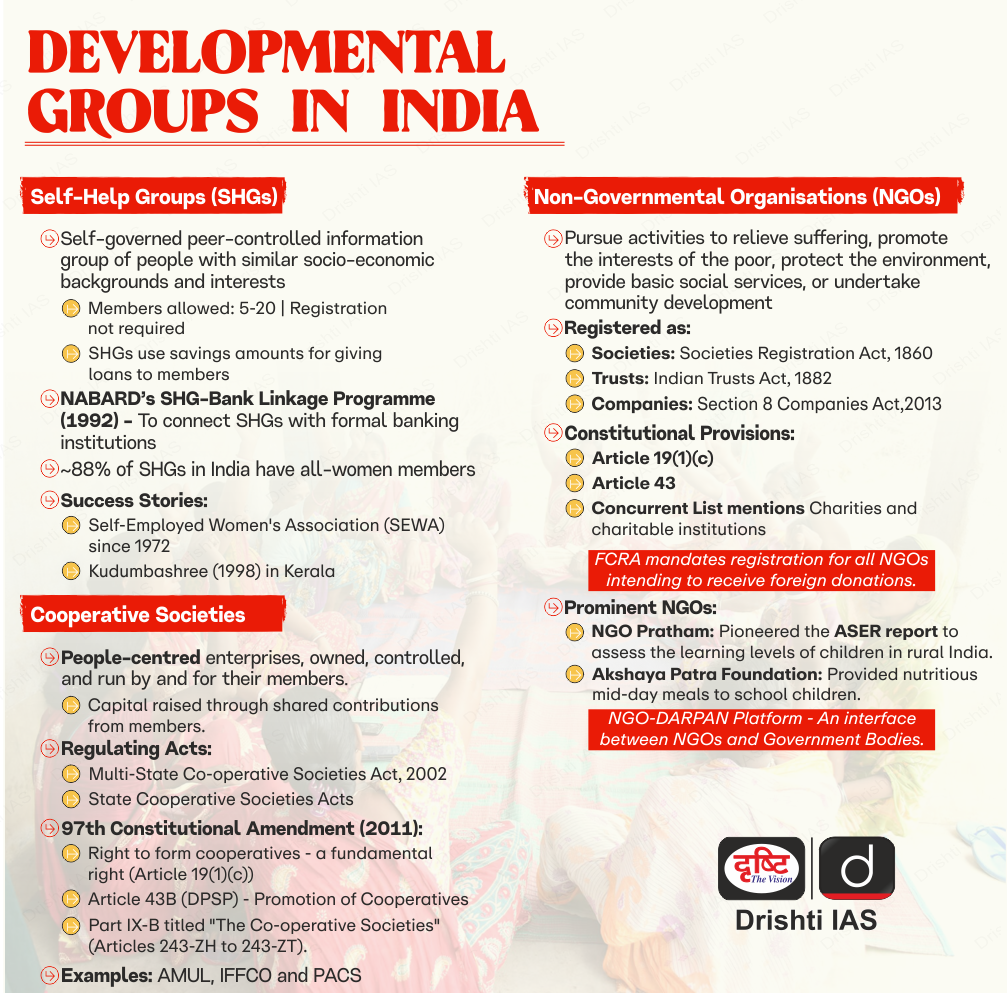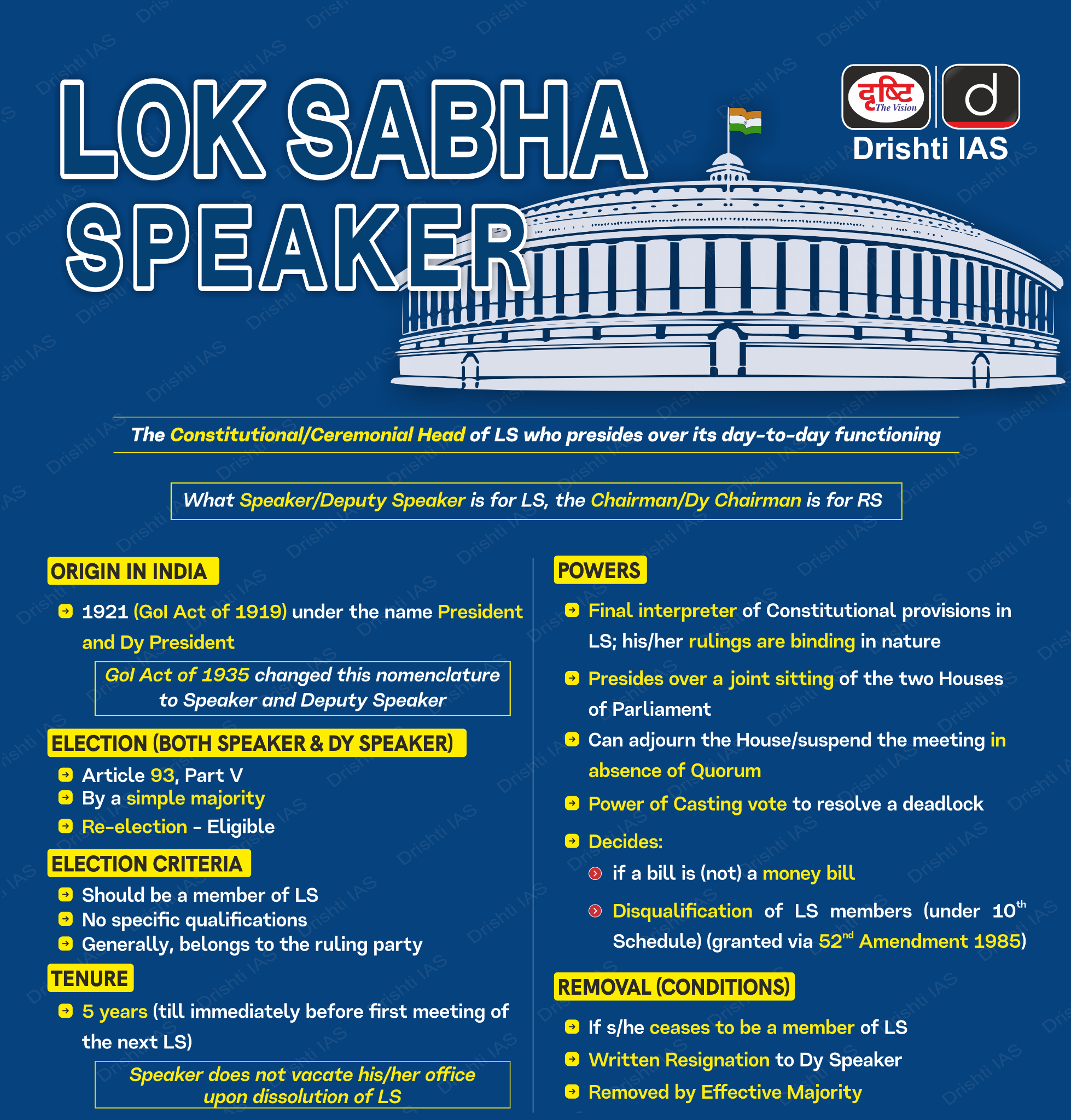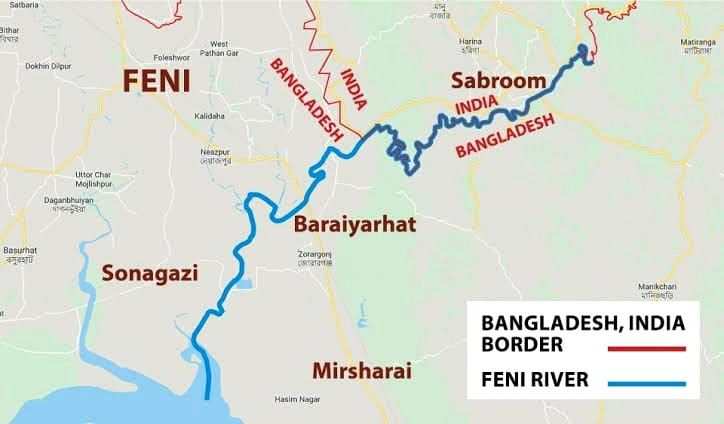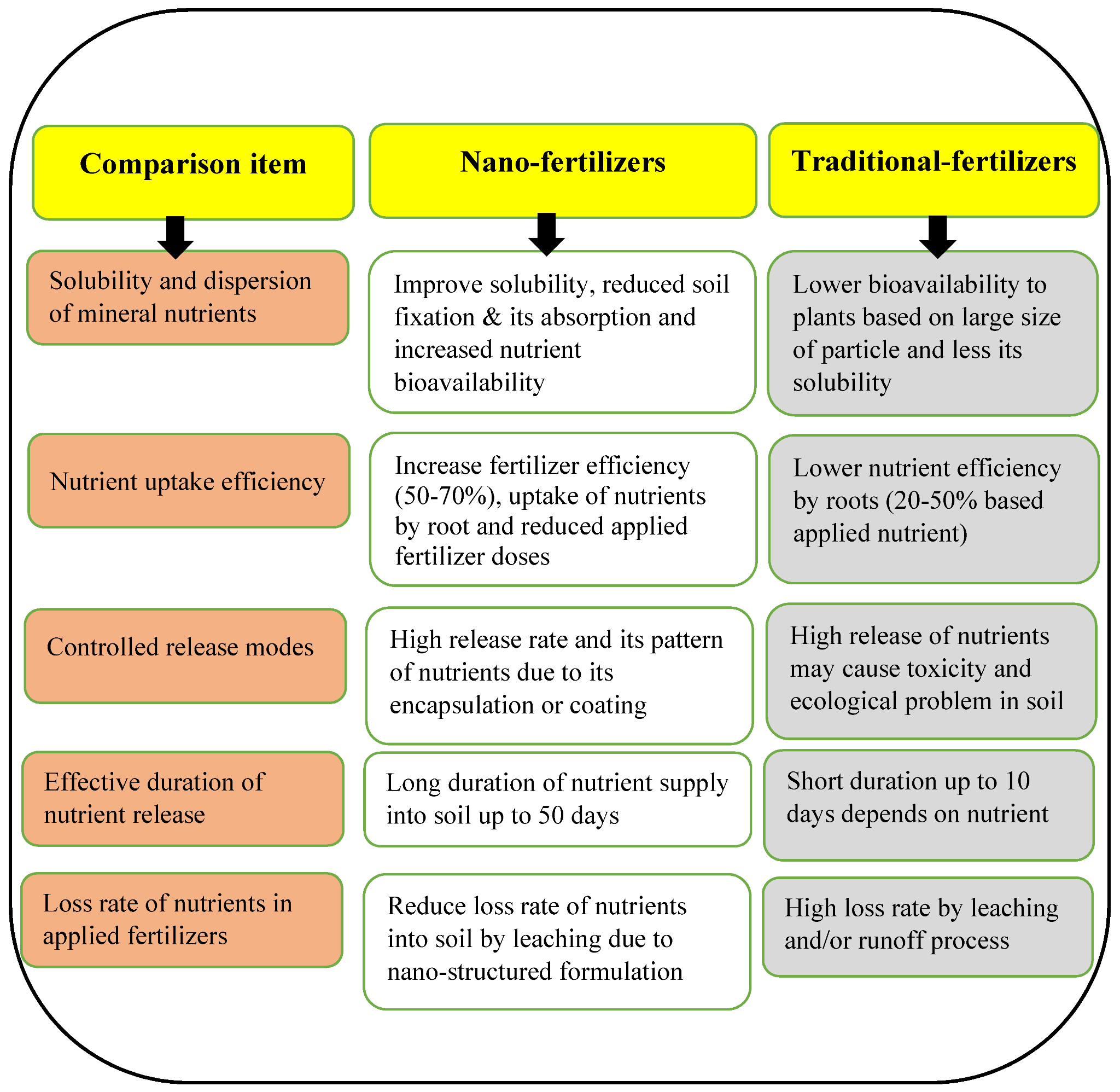Infographics
Developmental Groups in India
Read More: SBI's Study on Empowering Women Through SHGs, Cancellation of FCRA Registration of NGOs, India’s Cooperative Sector.

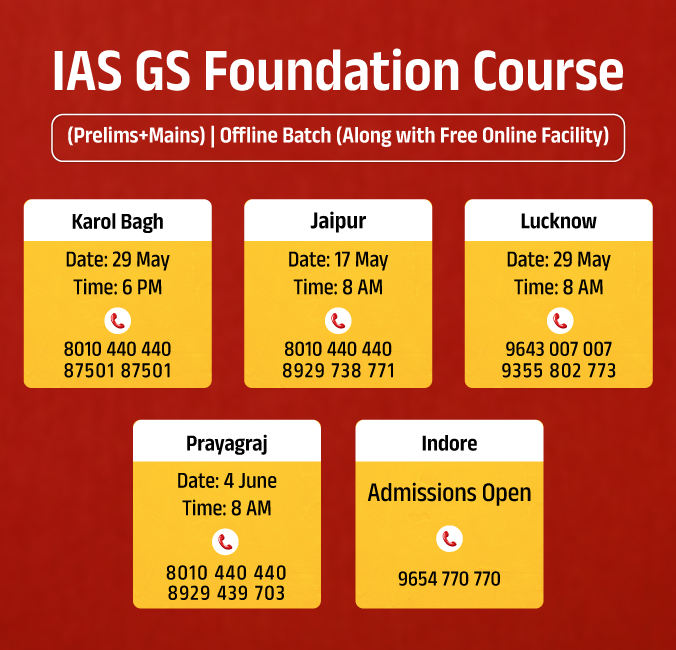
Indian Polity
Role of the Speaker
For Prelims: 18th Lok Sabha, coalition government, Speaker and a Deputy Speaker, simple majority, adjournments, no-confidence and censure motions, Business Advisory Committee, the General Purposes Committee and the Rules Committee, rights and privileges
For Mains: Key facts about the speaker in India, Role of Speaker in Coalition Government
Why in News?
The upcoming session of the 18th Lok Sabha underscores the crucial role of the Speaker in the case of coalition government not only for the smooth functioning of the house but also for the balance of power between the ruling party and its allies, as well as the opposition.
What are the Key Facts About the Speaker in India?
- About:
- The Speaker is the constitutional and ceremonial head of the House.
- Each House of Parliament has its own presiding officer.
- There is a Speaker and a Deputy Speaker for the Lok Sabha and a Chairman and a Deputy Chairman for the Rajya Sabha.
- The Speaker is assisted by the Secretary-General of the Lok Sabha and senior officers of the Secretariat on parliamentary activities, practice and procedure.
- In the absence of the Speaker, the Deputy Speaker discharges the functions.
- A member from the panel of Chairmen presides over the House in the absence of both the Speaker and the Deputy Speaker. However, member of the panel of chairpersons cannot preside over the house, when the office of the Speaker or the deputy speaker is vacant.
- Election:
- The House elects its presiding officer by a simple majority of members present, who vote in the House.
- Usually, a member belonging to the ruling party is elected as speaker whereas deputy speaker is elected from opposition party .
- There are also instances when members not belonging to the ruling party were elected to the office of the Speaker.
- GMC Balayogi and Manohar Joshi belonging to the non-ruling party served as the Speaker in the 12th and 13th Lok Sabha.
- When the Lok Sabha is dissolved, the Speaker remains in his office till the first meeting of the new assembly when the new speaker is elected.
- Removal:
- The Constitution has given the Lower House authority to remove the Speaker if needed.
- The House can remove the Speaker through a resolution with notice of 14 days, passed by an effective majority (more than 50% of the effective strength (total strength-vacancies) of the house present and voting) as per Articles 94 of the Indian Constitution.
- The Speaker can also be removed on getting disqualified from being a Lok Sabha member under sections 7 and 8 of the Representation of the People Act, 1951.
- A speaker can also give his resignation to a Deputy Speaker.
- The Constitution has given the Lower House authority to remove the Speaker if needed.
- Sources of Power and Duties:
- The Speaker of the Lok Sabha derives his powers and duties from three sources:
- Constitution of India,
- Rules of Procedure and Conduct of Business of Lok Sabha,
- Parliamentary Conventions (residuary powers that are unwritten or unspecified in the rules)
- The Speaker of the Lok Sabha derives his powers and duties from three sources:
- Provisions to Ensure Independence and Impartiality of Speaker:
- He is provided with a security of tenure. He can be removed only by a resolution passed by the Lok Sabha by a effective majority.
- His salaries and allowances are charged on the Consolidated Fund of India and thus are not subject to the annual vote of Parliament.
- His work and conduct cannot be discussed and criticised in the Lok Sabha except on a substantive motion.
- His powers of regulating procedure or conducting business or maintaining order in the House are not subject to the jurisdiction of any Court.
- He cannot vote in the first instance. He can only exercise a casting vote in the event of a tie. This makes the position of speaker impartial.
- He is placed at sixth rank in the order of precedence along with the Chief Justice of India.
Pro Tem Speaker
- When the Speaker of the last Lok Sabha vacates his office immediately before the first meeting of the newly-elected Lok Sabha, the President appoints a member of the Lok Sabha as the Speaker Pro Tem (usually, the senior most member).
- The President himself administers oath to the Speaker Pro Tem.
- He/She presides over the first sitting of the newly-elected Lok Sabha and has all the powers of the Speaker.
- The main responsibility is to administer oaths to the new members and to enable the House to elect the new Speaker.
- When the new Speaker is elected by the House, the office of the Speaker Pro Tem ceases to exist.
What are the Roles and Responsibilities of the Speaker?
- Presiding Over House Proceedings:
- The Speaker oversees the sessions of the Lower House, ensuring discipline and decorum among members.
- The Speaker decides the agenda for parliamentary meetings and interprets procedural rules. He/she permits motions such as adjournments, no-confidence and censure motions , ensuring orderly conduct.
- The Speaker is the final interpreter of the provisions of (a) the Constitution of India, (b) the Rules of Procedure and Conduct of Business of Lok Sabha, and (c) the parliamentary precedents, within the House.
- Enforcing Quorum and Disciplinary Action:
- In the absence of a quorum, the Speaker adjourns or suspends meetings until the required attendance is met.
- The speaker has the power to punish unruly behaviour and even disqualify members on grounds of defection under 10th schedule of the constitution.
- Constitution of Committees:
-
The Committees of the House are constituted by the speaker and function under the speaker’s overall direction.
- The Chairmen of all Parliamentary Committees are nominated by Speaker.
- Committees like the Business Advisory Committee, the General Purposes Committee and the Rules Committee, work directly under his Chairmanship.
-
- Privileges of the House:
-
The Speaker is the guardian of the rights and privileges of the House, its Committees and members.
- It depends solely on the speaker to refer any question of privilege to the Committee of Privileges for examination, investigation and report.
- He can allow a ‘secret’ sitting of the House at the request of the Leader of the House. When the House sits in secret, no stranger can be present in the chamber, lobby or galleries except with the permission of the Speaker.
-
- Administrative Authority:
- As head of the Lok Sabha Secretariat, the Speaker manages administrative affairs and security arrangements within the Parliament Estate. They control alterations and additions to parliamentary infrastructure.
- Inter-Parliamentary Relations:
- The Speaker serves as the ex-officio President of the Indian Parliamentary Group, facilitating inter-parliamentary relations. He/she leads delegations abroad and chairs the Conference of Presiding Officers of Legislative Bodies in India.
Constitutional Provisions Related to Speaker/Deputy Speaker
- Article 93/178: Appointment of the Speaker and Deputy Speaker of the Lok Sabha/ Legislative Assembly.
- Article 94/179: Vacation/resignation/removal from the offices of Speaker and Deputy Speaker of the Lok Sabha/Legislative Assembly.
- Article 95/180: Power of the Deputy Speaker or other person(s) to perform the duties of the office of or to act as the Speaker of the Lok Sabha/Legislative Assembly.
- Article 96/181: The Speaker or the Deputy Speaker not to preside while a resolution for his removal from office is under consideration.
- Article 97/186: Salaries and allowances of the Speaker and Deputy Speaker.
Judicial Provisions Related to Speaker/Deputy Speaker
- In Kihoto Hollohan versus Zachilhu case, 1993, the Supreme Court declared that the decision of the presiding officer is not final and can be questioned in any court. It is subject to judicial review on the grounds of malafide, perversity, etc
- Supreme Court in Keisham Meghachandra Singh vs The Hon’ble Speaker Manipur Legislative Assembly & Ors Case, 2020, ruled that Speakers of assemblies and the Parliament must decide disqualification pleas within a period of three months except in extraordinary circumstances.
- In Nabam Rebia vs Deputy Speaker Case, 2016, the SC held that a speaker will be disabled from deciding disqualification petitions under the anti-defection law (10th schedule of the constitution) if a notice for their removal is pending.
- In other words, this judgement stopped a Speaker facing removal notice from deciding disqualification pleas against members of legislatures under anti-defection law.
- Also, in 2023, the Supreme Court in Subhash Desai v Principal Secretary, Governor of Maharashtra Case, 2023, directed the Maharashtra Assembly Speaker, to set a timeline for deciding pleas for the disqualification of MLAs.
What are the Issues Associated With the Office of the Speaker?
- Partisanship Issue: The Speaker, often belonging to the ruling party, are accused of bias. Supreme Court in Kihoto Hollohan versus Zachilhu case highlighted the instances where speakers have allegedly acted in favour of their party.
- For example, discretionary powers of speakers with political affiliations in deciding money bill and political defection cases is one such example.
- In 2017, the Manipur legislative assembly anti-defection case, the court gave a reasonable period of four weeks but the defection complaint was pending for years.
- Prioritising Party Interests over National Interest: Speakers have the power to restrict debates or discussions that could potentially affect the agenda of the political parties, if those discussions are crucial for the nation's well-being.
-
Increased Disruptions and Stalling of Proceedings: A Speaker perceived as biased can lead to frustration and disruptions from the opposition, ultimately hindering the functioning of Parliament.
-
Bypassing Committees and Scrutiny: Rushing through bills without proper committee review can lead to poorly crafted legislation that hasn't received sufficient deliberation.
- Example: The instance of the passing of 3 farm laws in 2020 without referring it to parliamentary committe has been cited as the reason by opposition for widespread protest and later their withdrawal.
Way Forward
- Maintaining Stability: The Speaker's impartiality and fairness are critical, as they have to balance the complex dynamics of diverse political interests
- Their decisions on issues such as the admission of no-confidence motions, the allocation of time for debates, and the recognition of members can have a significant impact on the government's stability.
- Role in Resolving Disputes:
- In the case of a coalition government, where multiple parties with different ideologies and agendas come together, conflicts and disputes are inevitable.
- The Speaker should uphold impartiality in mediating these disputes and finding solutions that are acceptable to all stakeholders.
- Impact on Legislative Outcomes: By controlling the legislative agenda, the Speaker can influence the passage of bills and the overall policy direction of the government.
- Pranab Mukherjee, former President of India, noted, "The Speaker's role is not just about running the House; it's about being a bridge between the government and the opposition, and ensuring that the democratic process is upheld."
- Ensuring Non-Partisanship: The practice of the Speaker who resigns from their political party to ensure complete non-partisanship can be explored further to uphold the Constitution's principle of separation of powers.
- The example of N. Sanjiva Reddy resigning from his party upon becoming Speaker in 1967 sets a positive precedent of non-partisanship.
- In Britain, the speaker is strictly a nonparty member. There is a convention that the speaker has to resign from his party and remain politically neutral.
Conclusion
The Speaker of Lok Sabha is not just a presiding officer, they wield significant power in shaping the functioning of the House and influencing the balance between the ruling party and the opposition,especially in the case of coalition government. The Speaker's decisions and actions can have far-reaching consequences for the functioning and stability of the government.
|
Drishti Mains Question: Q. Highlighting the powers and responsibilities of the speaker in Indian parliamentary system,discuss about its crucial role in ensuring parliamentary democracy. |
UPSC Civil Services Examination, Previous Year Questions (PYQs)
Prelims
Q. With reference to Deputy Speaker of Lok Sabha, consider the following statements: (2022)
- As per the Rules of Procedure and Conduct of Business in Lok Sabha, the election of Deputy Speaker shall be held on such date as the Speaker may fix.
- There is a mandatory provision that the election of a candidate as Deputy Speaker of Lok Sabha shall be from either the principal opposition party or the ruling party.
- The Deputy Speaker has the same power as of the Speaker when presiding over the sitting of the House and no appeal lies against his rulings.
- The well-established parliamentary practice regarding the appointment of Deputy Speaker is that the motion is moved by the Speaker and duly seconded by the Prime Minister.
Which of the statements given above are correct?
(a) 1 and 3 only
(b) 1, 2 and 3
(c) 3 and 4 only
(d) 2 and 4 only
Ans: (b)
Mains:
Q. To what extent, in your view, the Parliament is able to ensure accountability of the executive in India? (2021)
Q. How far do you think cooperation, competition and confrontation have shaped the nature of federation in India? Cite some recent examples to validate your answer. (2020)


Indian Economy
National Health Claim Exchange
For Prelims: Insurance Regulatory and Development Authority of India (IRDAI), healthcare and health insurance ecosystem, out-of-pocket expenses, data privacy
For Mains: Key features of the National Health Claim Exchange (NHCX), Need for the National Health Claim Exchange in India.
Why in News?
Recently, the National Health Authority (NHA) and the Insurance Regulatory and Development Authority of India (IRDAI) launched the National Health Claim Exchange (NHCX) to facilitate the exchange of claims-related information among stakeholders in the healthcare and health insurance ecosystem.
What is the National Health Claim Exchange (NHCX)?
- About:
- It is a digital platform designed to streamline health insurance claims processing in India.
- It will act as a centralised hub for all health claims, alleviating the administrative burden on hospitals and providing a seamless, paperless, and secure contractual framework.
- The system is designed to accommodate the dynamic and diverse healthcare system of India, aligning with IRDAI’s objective of achieving ‘Insurance for All by 2047’.
- Advantages:
- NHCX aims to simplify and expedite the cashless claims process, potentially reducing waiting times and out-of-pocket expenses for patients.
- NHCX streamlines claim processing by eliminating the need for multiple portals and manual paperwork, reducing administrative burdens for hospitals.
- The platform could lead to a more standardised approach to healthcare pricing through uniform data presentation and centralised validation.
- The system can help detect and prevent fraudulent claims through data verification.
Note
Out-of-Pocket Expenditure (OOPE):
- Out-of-Pocket Expenditure (OOPE) is the money paid directly by households, at the point of receiving health care.
- It excludes the individuals covered under any public or private insurance or social protection scheme.
As per IRDAI, Status of Insurance in India:
- Health insurance contributes to approximately 29% of the total general insurance premium income in India.
- In life insurance business, India is ranked 10th in the world. India's share in global life insurance market was 2.73% during 2019.
- In non-life insurance business, India is ranked 15th in the world. India's share in global non-life insurance market was 0.79% during 2019.
Insurance Penetration and Density:
- Insurance penetration and density are two metrics, among others, often used to assess the level of development of the insurance sector in a country.
- Insurance penetration is measured as the percentage of insurance premiums to GDP.
- Insurance penetration which was 2.71% in 2001 has steadily increased to 3.76% in 2019 (Life 2.82% and Non-Life 0.94%).
- Insurance density is calculated as the ratio of premiums to population (per capita premium).
- The insurance density in India which was USD 11.5 in 2001, reached to USD 78 in 2019 (Life- USD 58 and Non-Life - USD 20).
Government initiatives Related to Health Insurance:
- Pradhan Mantri Jeevan Jyoti Yojana (PMJJBY)
- Bima Sugam, Bima Vistar, Bima Vaahaks
- National health Policy 2017 envisages health insurance as an important quality service as well as to increase population coverage reduces catastrophic expenditure in health sector.
What is the Need for the National Health Claim Exchange in India?
- High Out-of-Pocket Expenditure: A study highlights the importance of health insurance in reducing out-of-pocket expenses.
- The data showcases a concerning reliance on private insurance for hospitalisation, especially in rural areas (73.5 cases per 100,000 people).
- Streamlined claims processing through NHCX can lead to faster claim settlements, potentially reducing financial burdens for patients.
- This can incentivize more people to utilise health insurance, ultimately reducing reliance on out-of-pocket payments and improving financial security.
- Inefficiencies in Claim Processing: Varying requirements and processes of different insurance companies lead to delays and errors in claim decisions and lack of transparency for patients behind claim approvals or denials.
- High Operational Costs for Hospitals: Currently, hospitals in India face administrative burdens due to the multiple portals for different insurance companies as well as manual processes for submitting and tracking claims.
What are the Hurdles in the Adoption of the National Health Claim Exchange (NHCX)?
- Digital Adoption Gap: Encouraging both hospitals and insurance companies to fully integrate with the NHCX platform requires ongoing efforts and training.
- Example: Hospitals, especially smaller ones in rural areas, may lack the necessary IT infrastructure or trained staff to fully integrate with the NHCX platform.
- Building Trust and Collaboration: For the success of NHCX, building trust among policyholders through delivery of efficient services and streamlined claim processes.
- Example: Historically, communication gaps and complexities between hospitals and insurance companies have led to claim processing issues.
- Data Security Concerns: Robust measures are essential to ensure data privacy and prevent security breaches.
- Example: With a centralised platform handling sensitive health and financial data, robust cybersecurity measures are crucial to prevent data breaches.
Conclusion
The NHCX is not just a technological advancement, it's a critical step towards improving healthcare accessibility and affordability in India. By addressing the current inefficiencies and complexities, NHCX has the potential to empower patients, hospitals, and insurance companies for a healthier future.
|
Drishti Mains Question: Q. Highlighting the key features of the National Health Claim Exchange (NHCX),discuss the hurdles in its adoption in India. |
UPSC Civil Services Examination, Previous Year Questions (PYQs)
Prelims:
Q. Which of the following are the objectives of ‘National Nutrition Mission’? (2017)
- To create awareness relating to malnutrition among pregnant women and lactating mothers.
- To reduce the incidence of anaemia among young children, adolescent girls and women.
- To promote the consumption of millets, coarse cereals and unpolished rice.
- To promote the consumption of poultry eggs.
Select the correct answer using the code given below:
(a) 1 and 2 only
(b) 1, 2 and 3 only
(c) 1, 2 and 4 only
(d) 3 and 4 only
Ans: (a)
Mains:
Q. Performance of welfare schemes that are implemented for vulnerable sections is not so effective due to the absence of their awareness and active involvement at all stages of the policy process – Discuss. (2019)

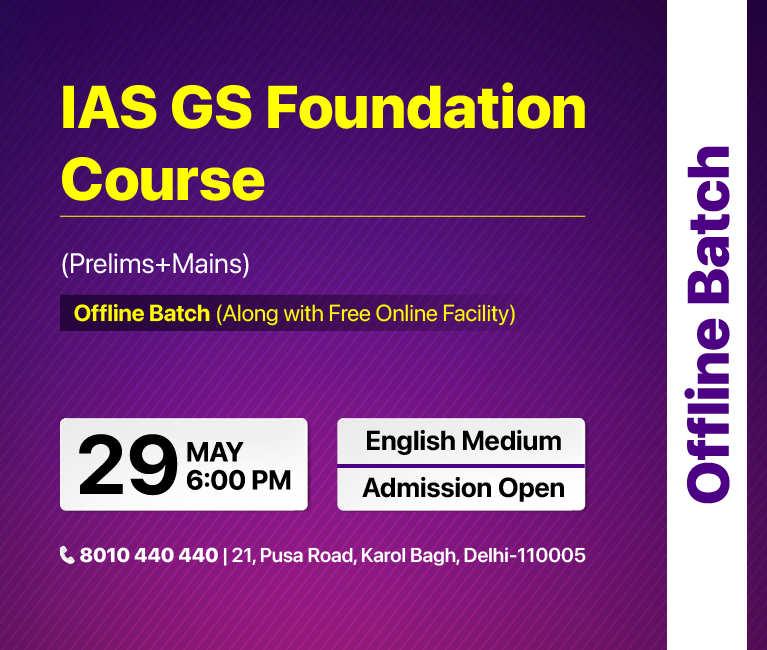
Indian Polity
Greater Authority to Panchayats
For Prelims: Panchayati Raj Institutions (PRIs), 73rd Constitutional Amendment Act, 1992, Gram Sabhas, Panchayat Samithis, Zila Parishads, Article 243G, Article 243H, Article 243-I.
For Mains: Financial empowerment of PRI, Fiscal decentralisation, Inter-state disparities,, Role of Women's Self-Help Groups (SHGs)
Why in News?
Recently a World Bank working paper, ‘Two Hundred and Fifty-Thousand Democracies: A Review of Village Government in India’ has called for granting greater authority to Panchayats while strengthening local fiscal capacity to ensure effective local governance.
What is a Panchayati Raj Institution (PRI)?
- Historical Background:
- Village government in India has a long, varied and dynamic history. Kautilya’s Arthashastra, a treatise on governance that dates back to around 200 BCE, describes a decentralised system of government where villages were ruled by village headmen who were called by various names gramika, gramakuta or adhyaksha.
- The Rig Veda, a Vedic text which is over 3,000 years old, refers to three types of institutions namely vidhata, sabha, and samiti, which were all assemblies of adults who gather to voice their views and participate in decision-making.
- Views of Gandhian and Ambedkar on PRI:
- Dr B R Ambedkar famously argued in the Indian Constituent Assembly against village democracies. He argued that villages are nothing, but a sink of localism, a den of ignorance, narrow mindedness and communalism.
- However, for Gandhi, the village formed the bedrock of his idea of a free India. India, he famously declared, ”is to be found not in its few cities but in its 700,000 villages.”
- Gandhi envisioned a village life centred around three key tenets namely self-sufficiency and frugality, deliberative and representative democracy, and community-spiritedness.
- Post Independence:
- The Gandhian idea of village-led free democratic India was rejected by the principal architects of post-independent India.
- Dr. Ambedkar convinced the Constituent Assembly to include Panchayati Raj Institutions as non-mandatory guidelines in the Directive Principles, suggesting but not requiring their creation by regional governments.
- In 1992, the devolution of formal power to Panchayats commenced with the passage of the 73rd Amendment act.
- 73rd Constitutional Amendment Act, 1992:
- The 73rd Constitutional Amendment Act, 1992 gave constitutional status to the PRIs and established a system of uniform structure, elections, reservation of seats for Scheduled Caste, Scheduled Tribes and women and devolution of fund, functions and functionaries to PRIs.
- The amendment mandated a three-tier system of local government across states, consisting of village (Gram Panchayat), intermediate (Block Panchayat), and district (Zilla Panchayat) levels.
- Provisions:
- Article 243G of the Constitution of India gives state legislatures the power to provide Panchayats with the authority and powers to function as self-government institutions.
- For the financial empowerment of Panchayats, provisions have been made in terms of Article 243H and Article 243-I of the Constitution.
- Article 243H gives state legislatures the power to authorize Panchayats to levy, collect, and appropriate taxes, duties, tolls, and fees.
- Article 243-I mandates the formation of state finance commissions every five years by the Governor.
- The Ministry of Panchayati Raj looks into all matters relating to the Panchayati Raj and Panchayati Raj Institutions. It was created in May 2004.
Related Initiatives
- SVAMITVA Scheme: Survey of Villages and Mapping with Improvised Technology in Village Areas (SVAMITVA) scheme was launched on National Panchayati Raj Day 2020 to enable economic progress of Rural India by providing “Record of Rights” to every rural household owner.
- e-Gram Swaraj e-Financial Management System: e-Gram Swaraj is a Simplified Work Based Accounting Application for Panchayati Raj.
- Geo-Tagging of Assets: The Ministry of Panchayati Raj (MoPR) has developed “mActionSoft”, a mobile based solution to help in capturing photos with Geo-Tags (i.e., GPS Coordinates) for the works which have assets as an output.
- Citizen Charter: In order to focus on the commitment of the PRIs towards its Citizens in respect of Standard of Services, the MoPR has provided a platform to upload Citizen Charter documents with the slogan “Meri Panchayat Mera Adhikaar – Jan Sevaayein Hamaare Dwaar”.
What are the Challenges Faced by the Panchayats?
- Fiscal Decentralisation Issues: Insufficient devolution of financial powers and functions from higher levels of government to panchayats hampers their ability to mobilise resources independently.
-
Limited fiscal decentralisation undermines local governance and community empowerment.
-
- Low Capacity and Utilisation: PRI’s may lack the capacity and skills to generate their own revenue from various sources, such as fees, tolls, rents, etc.
- They also face challenges in utilising the funds efficiently and effectively, due to poor planning, monitoring, and accountability mechanisms.
- Top-down Approach: Dependence on external funding leads to interference from higher tiers of government mainly central and state governments.
- Delay in Funding: Some regions have also reported non-receipt of funds under key schemes, impacting their functioning.
- The Standing Committee on Rural Development and Panchayati Raj in March, 2023 said that 19 out of 34 State/UTs did not receive any funds under the Rashtriya Gram Swaraj Abhiyan scheme in FY23.
What is the Status of PRI Funding?
- As per the Reserve Bank of India (RBI) report on the financial dynamics of Panchayati Raj Institutions (PRIs) in India:
- Revenue Composition: Panchayats earn only 1% of their revenue through taxes.
- The majority of their revenue comes from grants provided by the Centre and the States.
- Data indicates that 80% of the revenue is from Central government grants, while 15% is from State government grants.
- Revenue Per Panchayat: On average each panchayat earned just Rs 21,000 from its own tax revenue and Rs 73,000 from non-tax revenue.
- Conversely, grants from the Central government amounted to approximately Rs 17 lakh per panchayat, with State government grants totalling over Rs 3.25 lakh per panchayat.
- State Revenue Share and Inter-State Disparities: Panchayats' share in their respective State's own revenue remains minimal. There are wide variations among states regarding average revenue earned per panchayat.
- Kerala and West Bengal lead with average revenues of over Rs 60 lakh and Rs 57 lakh per panchayat, respectively. While States like Andhra Pradesh, Haryana, Mizoram, Punjab, and Uttarakhand have significantly lower average revenues, less than Rs 6 lakh per panchayat.
What are the Steps Needed to Strengthen PRI?
- Reassess the Levels of Devolution: Pay more attention to the three critical Fs namely functions, finance, and functionaries and delegate more authority to panchayats rather than stripping them of power.
- Enhanced Fiscal Capacity: To improve governance, there's a need to enhance the fiscal capacity of Panchayats. For example utilising the Social Stock Exchange for bringing in additional funds.
- Additionally granting them more decision-making authority over finances will reduce the burden on higher-level bureaucrats.
- Empowerment of Ward Members: Ward Members (WMs) lack financial resources and often just endorse decisions, but they can be crucial in overseeing Gram panchayat heads.
- Empowering them with funds could enhance Panchayat effectiveness, as smaller political units show better development outcomes.
- Strengthen Gram Sabhas: Gram sabhas are central to effective village governance. To enhance their efficacy, it is recommended to increase their frequency and expand their powers to encompass critical areas such as village planning and the selection of beneficiaries for public programs.
- Improve Administrative Data Quality: Enhance the quality of administrative data and ensure its public availability in an accessible format. Visualisations and interactive dashboards can facilitate understanding and analysis by all community members.
- Performance Incentives and Accountability: Establishing an independent and credible system for scoring Panchayat performance is suggested. Incentivising Panchayat elected officials and staff based on performance could improve accountability.
- Grievance Redressal Systems: Setting up formal and effective grievance redressal systems is crucial for holding Panchayats accountable. This allows individual citizens to report problems to higher authorities.
- Integration of Women's Self-Help Groups (SHGs): Integrating SHGs with Panchayats is seen as a significant measure for improving village governance and balancing decision-making towards the needs of women.
Read more: Panchayati Raj Institution (PRI)
|
Drishti Mains Question: Q. Discuss the strategies for strengthening the Panchayati Raj Institutions (PRIs) in India. |
UPSC Civil Services Examination, Previous Year Questions (PYQs)
Prelims
Q1. Local self-government can be best explained as an exercise in (2017)
(a) Federalism
(b) Democratic decentralisation
(c) Administrative delegation
(d) Direct democracy
Ans: (b)
Q. The fundamental object of Panchayati Raj system is to ensure which among the following? (2015)
- People’s participation in development
- Political accountability
- Democratic decentralisation
- Financial mobilisation
Select the correct answer using the code given below
(a) 1, 2 and 3 only
(b) 2 and 4 only
(c) 1 and 3 only
(d) 1, 2, 3 and 4
Ans: (c)
Mains
Q. To what extent, in your opinion, has the decentralisation of power in India changed the governance landscape at the grassroots? (2022)
Q. Assess the importance of the Panchayat system in India as a part of local government. Apart from government grants, what sources can the Panchayats look out for financing developmental projects? (2018)
Q. In absence of a well-educated and organised local level government system,`Panchayats’ and ‘Samitis’ have remained mainly political institutions and not effective instruments of governance. Critically discuss. (2015)


Governance
Pradhan Mantri Awas Yojana
For Prelims: Prime Minister, PMAY-Gramin, PMAY-Urban, Below Poverty Line (BPL), SCs/STs, Geo-tagging, Statutory Towns, Slum dwellers, Credit Linked Subsidy, CAG, Swachh Bharat Mission, MGNREGA, Jal Jeevan Mission, Ujjwala Yojana, NABARD, Economically Weaker Sections (EWS), Awaas Bhandu
For Mains: Challenges to PMAY, Steps needed to strengthen PMAY
Why in News?
Recently, the Prime Minister approved aid for building three crore houses under PMAY, with two crore under PMAY-Gramin and one crore under PMAY-Urban.
- The government announced that additional housing units will be built beyond those planned under PMAY-G and PMAY-U by December 2024, extending the original target from March 2022.
What is Pradhan Mantri Awas Yojana?
- Pradhan Mantri Awaas Yojana- Gramin (PMAY-G):
- Launch: To achieve the objective of “Housing for All” by 2022, the erstwhile rural housing scheme Indira Awaas Yojana (IAY) was restructured to Pradhan Mantri Awaas Yojana-Gramin (PMAY-G) from 1st April 2016, as a centrally sponsored scheme.
- Ministry Involved: Ministry of Rural Development.
- Status: States/UTs have sanctioned 2.85 crore houses to the beneficiaries and 2.22 crore houses have been completed till March 2023.
- Aim: To provide a pucca house with basic amenities to all rural families, who are homeless or living in kutcha or dilapidated houses by the end of March 2022.
- To help rural people Below the Poverty Line (BPL) in the construction of dwelling units and upgradation of existing unserviceable kutcha houses by assisting in the form of a full grant.
- Beneficiaries: People belonging to SCs/STs, freed bonded labourers and non-SC/ST categories, widows or next-of-kin of defence personnel killed in action, ex-servicemen and retired members of the paramilitary forces, disabled persons and minorities.
- Selection of Beneficiaries: Through a three-stage validation such as Socio-Economic Caste Census 2011, Gram Sabha, and geo-tagging.
- Cost Sharing: The Centre and states share expenses in 60:40 ratio in case of plain areas, and in 90:10 ratio for northeastern states, two Himalayan states and the UT of Jammu and Kashmir.
- The Centre bears 100% cost in case of other Union Territories, including the UT of Ladakh.
- Pradhan Mantri Awas Yojana – Urban (PMAY-U):
- Launch: Launched on 25th June 2015 it intends to provide housing for all in urban areas by the year 2022.
- Implemented by: Ministry of Housing and Urban Affairs
- Status: As per the PMAY (U) dashboard, 118.64 lakh houses have been sanctioned out of which 83.67 lakh have been completed.
-
Features:
- Addresses Urban housing shortage among the Urban Poor including the Slum Dwellers by ensuring a pucca house for eligible urban poor.
- The Mission covers the entire urban area consisting of Statutory Towns, Notified Planning Areas, Development Authorities, Special Area Development Authorities, Industrial Development Authorities or any such authority under State legislation which is entrusted with the functions of urban planning & regulations.
- The Mission promotes women's empowerment by providing the ownership of houses in the name of female members or in a joint name.

- Scheme Implemented in Four Verticals:
- In-situ Rehabilitation of existing slum dwellers using land as a resource through private participation.
- Credit Linked Subsidy: People from Economically Weaker Section (EWS), Low Income Group (LIG), and Middle Income Groups (MIG-I and MIG-II) can get interest subsidies of 6.5%, 4%, and 3% on housing loans up to Rs. 6 lakh, Rs. 9 lakh, and Rs. 12 lakh respectively for buying or building houses.
- Affordable Housing in Partnership (AHP): Under AHP, Central Assistance of Rs. 1.5 Lakh per EWS house is provided by the Government of India.
-
Beneficiary-led Individual House Construction/Enhancement: Central Assistance upto Rs. 1.5 lakh per EWS house is provided to eligible families belonging to EWS categories for individual house construction/ enhancement.
Other Initiatives
What are the Challenges to Pradhan Mantri Awas Yojana?
- Delay in Implementation: The government initially set a deadline of constructing 29.5 million housing units under PMAY-G and 12 million under PMAY-U programmes by March 2022.
- However, the government missed this target and in August 2022 extended the deadline to ensure “housing for all” to December 2024.
- Improper Execution: Some states delay their contributions which drastically affects progress. In 2020, nine states had delayed the payment of 2,915.21 crores to the beneficiaries.
- Access to Finance: The disbursed amount of 1.2/1.3 lakh subsidy is not enough to build a house in rural areas therefore households need more funds from financial institutions to cover the shortfall.
- Quality of Housing: The CAG report found poor quality housing in PMAY-G due to lack of supervision, with beneficiaries unaware of construction standards and no mechanism ensuring the effectiveness of provided prototypes.
- Convergence: The PMAY scheme aims to coordinate with other government initiatives like Swachh Bharat Mission, MGNREGA, Jal Jeevan Mission, and Ujjwala Yojana for providing basic amenities during house construction, but reports highlight shortcomings in scheme coordination, such as incomplete toilets in Rajasthan leading to false claims of 'Open Defecation Free' status.
- Lack of Awareness: Many rural residents are unaware of PMAY or lack the needed documents, with illiteracy, poor awareness campaigns, and complex documentation hindering access to housing subsidies and loans.
Other Policy Related Issues in PMAY
- Kitchen: PMAY-G provided kitchens, but many prefer extra rooms instead, often cooking outside and using kitchen space as living rooms, which partly explains the limited uptake of PMUY (LPG gas).
- Cooking Fuel: Despite efforts, many PMAY-G households don't use LPG cylinders due to outdoor cooking habits and the cost of refills, hindering the PMAY and PMUY program integration.
- Toilet Use: 10% of toilets built with PMAY-G houses are unused. However it's unclear if this is due to community habits or poor installation and needs investigation.
- Drinking Water: The National Rural Drinking Water Programme (NRDWP) aims to provide piped water to most rural homes by 2022, but PMAY-G houses mainly rely on shared water points and lack proper waste collection, drainage, and street lighting.
- Source of Borrowing: Most PMAY-G beneficiaries take loans from private sources rather than banks to cover additional house construction costs, despite being aware of bank loan options, indicating a policy issue with bank loan accessibility.
What are the Steps Needed to strengthen PMAY?
- Timely Release of Funds: Some states face delays in receiving central government funds, with a reported deficit of 200 crores in 2020, prompting the need for timely release of state contributions and direct benefit transfers akin to MGNREGA.
- Formal Credit Facility: Progress of credit disbursal is slow as major banks like SBI don't have Economically weaker Section (EWS)-specific products due to high risk and low profits, needing government intervention for stable financing for 'Housing for All'.
- More Inclusive: The need of the hour is to acknowledge the limitations of the existing scheme and to devise an intervention solely intended to solve the housing problem of the landless rural population.
- Quality Assurance: It is recommended that the government strengthen the quality monitoring mechanisms. Measures like social audits can be considered.
- Awas Bandhu: Awas Bandhu (PMAY-G Local Motivators) are effectively speeding up progress in places like West Bengal and Odisha. With proper training, they can be an important instrument to enhance convergence possibilities.
|
Drishti Mains Question: Q. Discuss the key features and objectives of the Pradhan Mantri Awas Yojana (PMAY). Evaluate its impact on urban and rural housing. |
UPSC Civil Services Examination, Previous Year Question (PYQ)
Prelims:
Q. Among other things, which one of the following was the purpose for which the Deepak Parekh Committee was constituted? (2009)
(a) To study the current socio-economic conditions of certain minority communities
(b) To suggest measures for financing the development of infrastructure
(c) To frame a policy on the production of genetically modified organisms
(d) To suggest measures to reduce the fiscal deficit in the Union Budget
Ans: (b)
Q. In the context of the Indian economy, non-financial debt includes which of the following? (2020)
- Housing loans owed by households
- Amounts outstanding on credit cards
- Treasury bills
Select the correct answer using the code given below:
(a) 1 only
(b) 1 and 2 only
(c) 3 only
(d) 1, 2 and 3
Ans: (d)
Mains:
Q. With a brief background of quality of urban life in India, introduce the objectives and strategy of the ‘Smart City Programme.” (2016)
Q. Discuss the various social problems which originated out of the speedy process of urbanization in India. (2013)


Important Facts For Prelims
Authorised Economic Operators Programme
Why in News?
Recently, the gem and jewellery sector has been granted Authorised Economic Operator (AEO) status by the Ministry of Finance, easing export-import processes with shorter cargo release times and reduced bank guarantees.
What is the Authorised Economic Operators Programme?
- The Authorised Economic Operator (AEO) programme is a global initiative launched in 2007 under the World Customs Organization's (WCO) SAFE Framework of Standards. It serves a dual purpose
- Enhancing International Supply Chain Security: The AEO programme aims to strengthen security measures throughout the international movement of goods, minimising risks associated with smuggling and counterfeiting.
- Facilitating Trade Flow: By recognising businesses that meet stringent security standards, the programme aims to expedite customs clearance processes, reducing delays and costs for legitimate traders.
- Under this, an entity engaged in international trade is approved by WCO as compliant with supply chain security standards and granted AEO status.
- An entity with an AEO status is considered a ‘secure’ trader and a reliable trading partner.
- Benefits of AEO status include expedited clearance times, fewer examinations, and improved security and communication between supply chain partners.
- AEO is a voluntary programme.
- India has also launched pilot project in 2011, the Indian AEO Programme that leverages the security standards established by the WCO SAFE Framework.
- This program offers a three-tiered system for both exporters and importers, allowing companies to progressively demonstrate their commitment to secure trade practices.
World Customs Organisation
- The World Customs Organization (WCO), established in 1952 as the Customs Co-operation Council (CCC) is an independent intergovernmental body whose mission is to enhance the effectiveness and efficiency of customs administrations.
- At present, it represents 183 customs administrations across the globe that collectively process approximately 98% of world trade.
- India became the vice-chair (regional head) of the Asia Pacific region of the WCO for a period of two years 2018- 2020.
- It is the only international organization with competence in customs matters and which can rightly call itself the voice of the international Customs community.
- It has its headquarters in Brussels, Belgium.
SAFE Framework
- In June 2005 the WCO Council adopted the Framework of Standards to Secure and Facilitate Global Trade (SAFE Framework) that would act as a deterrent to international terrorism, to secure revenue collections and to promote trade facilitation worldwide.
- The SAFE Framework has emerged as the global customs community’s concerted response to threats to supply chain security, equally supporting facilitation of legitimate and secure businesses.
- It prescribes baseline standards for trade facilitation that have been tested and are working well around the globe.
UPSC Civil Services Examination, Previous Year Questions (PYQs)
Prelims:
Q1. In the context of which of the following do you sometimes find the terms ‘amber box, blue box and green box’ in the news? (2016)
(a) WTO affairs
(b) SAARC affairs
(c) UNFCCC affairs
(d) India-EU negotiations on FTA
Ans: (a)
Q2. Consider the following statements: (2017)
- India has ratified the Trade Facilitation Agreement (TFA) of WTO.
- TFA is a part of WTO’s Bali Ministerial Package of 2013.
- TFA came into force in January 2016.
Which of the statements given above is/are correct?
(a) 1 and 2 only
(b) 1 and 3 only
(c) 2 and 3 only
(d) 1, 2 and 3
Ans: (a)


Important Facts For Prelims
Maitri Setu
Why in News?
The Maitri Setu, also known as the India-Bangladesh friendship bridge, is set to open by September, connecting India's landlocked Northeast to the Bay of Bengal.
What are the Key Facts about the Maitri-Setu?
- About:
- The bridge is 1.9 kilometres long and connects Sabroom in Tripura with Ramgarh in Bangladesh.
- Maitri Setu is constructed over the Feni River, which acts as a boundary between India (in Tripura) and Bangladesh.
- The name ‘Maitri Setu’ signifies the strengthening of bilateral relations and friendly ties between India and Bangladesh.
- It is a pre-stressed concrete bridge with a single-span structure that facilitates smooth traffic and cargo flow.
- The construction of the bridge has been supervised by the National Highways and Infrastructure Development Corporation Ltd. (NHIDCL).
- NHIDCL is a government-owned company established in 2014 for the development & maintenance of National Highways & Strategic Roads of India. It operates as a nodal agency of the Ministry of Road Transport and Highways (MoRTH).
- Significance:
- The bridge will play a central role in allowing India to transport goods from West Bengal to Northeast India through the Chittagong and Mongla Ports in Bangladesh.
- Cargo movement through the bridge is strategically important as Bangladesh's Chittagong port is just 80km from Tripura's Sabroom.
- It would serve as a new trade corridor between the two countries, helping in the development of Northeastern states. It will also enhance people-to-people connect between India’s northeast and Bangladesh.
- The bridge will play a central role in allowing India to transport goods from West Bengal to Northeast India through the Chittagong and Mongla Ports in Bangladesh.
- Bangladesh is the biggest trade partner of India in South Asia and an integral part of India's Act East Policy.
- The completion of Maitri Setu bridge will strengthen India’s strategic ties as well as bilateral trade with Bangladesh.
- The new maritime route from Kolkata to Chittagong will provide the quickest way for the movement of goods and an alternative to the Sittwe Port-Kaladan route.
Key Facts about Feni River
- It originates in the South Tripura district, passes through Sabroom town in India, and flows into Bangladesh before meeting the Bay of Bengal.
- The river is 116 kilometres long from its source to the Bay of Bengal.
- Some notable tributaries of the Feni River include the Muhuri River, Raidak River, Chandkhira River, Ryang River, and Kushiyara River.
UPSC Civil Services Examination, Previous Year Questions (PYQs)
Prelims
Q. With reference to river Teesta, consider the following statements: (2017)
- The source of river Teesta is the same as that of Brahmaputra but it flows through Sikkim.
- River Rangeet originates in Sikkim and it is a tributary of river Teesta.
- River Teesta flows into Bay of Bengal on the border of India and Bangladesh.
Which of the statements given above is/are correct?
(a) 1 and 3 only
(b) 2 only
(c) 2 and 3 only
(d) 1, 2 and 3
Ans: (b)


Rapid Fire
Software Technology Parks of India
Software Technology Parks of India (STPI) recently celebrated its 33rd Foundation Day.
- Software Technology Parks of India (STPI) was established and registered as an autonomous society under the Societies Registration Act 1860, in 1991 , under the Ministry of Electronics & Information Technology.
- The objective was to implement Software Technology Park (STP) and Electronics Hardware Technology Park (EHTP) schemes and set up and manage infrastructure facilities.
- STPI is nurturing the pan India start-up ecosystem through its initiatives like Centres of Entrepreneurship (CoEs) & Next Generation Incubation Scheme (NGIS).
- STPI launched a networking and resource discovery platform (SayujNet) and STPI Workspace portal (STPI-Workspace).
- The STPI announced “Ananta”, which will be a hyperscale cloud made by Indians for Indians.
- Apart from the conventional Compute Infrastructure Services (IAAS), Ananta will also offer PAAS (platform as a service), SaaS (software as a service) and graphics processing unit (GPU) based services.
- The DeepTech Knowledge Report on, ‘Cutting-Edge Tech Forging India as a Software Product Nation’, was also released to provide strategic insights into the current state of cutting-edge technologies in India.


Rapid Fire
Hawking Radiation
Recently, scientists proposed that small, hot "morsel" black holes, ejected during larger black hole mergers, could emit detectable high-energy photons. These morsel black holes would emit Hawking radiation (named after Stephen Hawking) at an increasing rate as they lose mass, leading to their explosive demise.
- Smaller black holes are hotter and emit Hawking radiation faster than larger ones.
- Gravitational waves could detect black hole mergers, followed by gamma-ray telescopes spotting high-energy photons from morsel black holes as they emit Hawking Radiation.
- It is predicted that the gravitational field of a black hole should cause the creation of particles, mostly photons directly from the vacuum of space.
- Hawking's Radiation:
- It is the idea that black holes leak thermal radiation, gradually evaporating and ending their existence with a final explosion.
- When one particle goes past the event horizon, it can't join back with its partner. The particles outside are known as Hawking radiation.
- The event horizon is a region of space beyond the black hole or "point of no return.


Rapid Fire
Pump and Dump Scheme
Recently, the Securities Exchange Board of India (SEBI) has slapped a fine on 11 individuals for allegedly operating a ‘pump and dump’ scheme.
- A pump-and-dump scheme is a type of manipulation activity that involves artificially inflating the price of a stock through false and misleading information, only to sell the stock at the inflated price and leave investors with significant losses.
- This manipulative tactic is particularly prevalent in the micro-cap and small-cap sectors, where companies often have limited public information and trading volumes are lower.
- Under the SEBI guidelines, pump-and-dump schemes are completely banned.
- Participants in pump-and-dump manipulation can face severe legal penalties, including fines, disgorgement of profits, and imprisonment.
- These schemes undermine confidence in the financial markets making legitimate investors wary of potential fraud.
- Pump and Dump scheme is different from Insider trading as there is no misuse of confidential information of company in pump and dump scheme.
- While, Insider trading is buying or selling a publicly traded company's stock by someone with information that could substantially impact an investor's decision to buy or sell a security that has not been made available to the public.


Rapid Fire
Nano-Fertilizer Plant at Kakinada
Recently, Coromandel International (an agriculture solutions provider) has opened a nano-fertiliser plant at its Kakinada complex in Andhra Pradesh.
- The nano fertilisers (such as Nano DAP and Nano urea) ensure optimal nutrient delivery and absorption by the plants, potentially replacing conventional fertilisers and increasing crop yield.
- Nano fertilisers are highly efficient types of fertilisers that provide nutrients like nitrogen to crops through fine granules.
- They are made up of nanoparticles, which are particles that are less than 100 nanometers in size.
- This small size allows the nanoparticles to penetrate plant cells more easily and deliver nutrients directly to the plant.
Read more: Nano Fertilisers, Nano DAP



